Exchange Currency
Slovak koruna
The Slovak koruna or Slovak crown was the currency of Slovakia between 8 February 1993 and 31 December 2008, and could be used for cash payment until the 16 January 2009. It is no longer the official Slovak currency.
The Slovak crown (koruna) was also the currency of the Nazi-era Slovak Republic between 1939 and 1945. Both korunas were subdivided into 100 haliers (abbreviated as "hal." or simply "h", singular: halier). The abbreviation is placed after the numeric value.
Slovakia switched its currency from the koruna to the euro on 1 January 2009, at a rate of 30.1260 korunas to the euro.
In the Slovak language, the nouns "koruna" and "halier" both assume two plural forms. "Koruny" and "haliere" appears after the numbers 2, 3 and 4 and in generic (uncountable) context, with "korún" and "halierov" being used after other numbers. The latter forms also correspond to genitive use in plural.
Czechoslovakia was part of the Austro-Hungarian Empire until the country gained its independence on October 28, 1918. Slovakia unilaterally declared independence on March 15th 1939; the remainder of Czechoslovakia was occupied by the Germans, who referred to the occupied area as the "Protectorate of Bohemia and Moravia. The Czechoslovak Republic was reconstituted on April 3, 1945, only to be separated into the Czech and Slovak Republics on January 1, 1993.
Austro-Hungarian Krone circulated in Czechoslovakia until it gained its independence in 1918. The Czech Koruna (CSO) was introduced on February 25, 1919. Germany introduced Reichsmarks in the Sudeten districts of Czechoslovakia in October 1938 and introduced them in Bohemia-Moravia in March 1939. The latter became the Protectorate of Bohemia and Moravia, in which they introduced a new Koruna at par with the Czech Koruna. German Reichsmarks also circulated in the Protectorate of Bohemia and Moravia. Hungary occupied southern Slovakia in October 1938, and Carpatho-Ukraine in March 1939, and circulated Pengos during their occupation. Poland occupied Teschen in October 1938 and issued Zloty during their occupation. Slovakia was given its own currency, the Slovak Koruna, which initially was at par with the Czech Koruna and equal to 10 Reichspfennig. On October 1, 1940, a new parity was established, devaluing the Slovak Koruna to 1 Reichsmark equal to 10 Czech Koruna or 11.62 Slovak Koruna. German Reichsmarks also circulated in Slovakia during World War II. The government and the Narodna Banka Slovensko (Slovak National Bank) issued banknotes during World War II.
The Soviets issued their own Koruna (CSR) during their occupation of Czechoslovakia, but it was replaced by a new Koruna once Czechoslovakia had in theory regained its independence. A Hard Koruna (CSK) replaced the new Koruna at the rate of 1 Hard Koruna equal to 5 New Koruna on June 1, 1953. This Koruna remained in use until January 1, 1993 when the Slovak Koruna (SKK) replaced the Czechoslovak Koruna (CSK) at par. See also Czechoslovakia.
The Koruna is divisible into 100 Halierov (Haleru). Banknotes were issued by the government between 1919 and April 1, 1926 and between 1938 and 1961. The National Bank of Czechoslovakia began issuing banknotes on April 1, 1926. The National Bank was nationalized on March 11, 1948 and renamed the State Bank of Czechoslovakia in 1950. The Narodna Banka Slovenska is the sole note-issuing authority for the Slovak Republic.
After the coming into existence of the Slovak Republic, the first Slovak coin to be released, at a nominal value of 10 Sk, was put into circulation on February 8, 1993, followed by the other coins, and concluded with the issue of the 10 hal coin (the lowest value), on October 29, 1993. Coins entering circulation in 1993 are marked as series 1993.
The basic material used for coins of lower nominal values is an alloy of aluminium and 2% or 4% magnesium. Coins of higher nominal values have a core of steel electroplated with nickel, bronze or copper. The coin with the highest nominal value, 10 Sk, is struck from aluminium and bronze alloy.
In 1996, the 50 hal coin, series 1996, was issued. It circulates parallel with the 50 hal coin with the same design from 1993. Its motif is identical with that of the original 50 hal coin; technical parameters and the material of the coin only have been changed. The base of the coin is carbon steel electroplated with copper.
The designer of all the coins, produced by Kremnica Mint, is Drahomir Zobek.
The obverse of the coins is of a unified composition. For coins of all nominal values, the coat of arms of the Slovak Republic is in the top half of the coin field. The name of the state appears on two lines under the coat of arms of the state, and the year of issue is further down. The Kremnica Mint mark "MK" is seen in the bottom of the coin field under the year of issue. Immediately beneath this is the letter "Z", indicating the initial of the surname of the designer of the coins.
On the reverse of the coins, there are, in addition to the nominal values, various historical motifs from the area of present day Slovakia.
The first new Slovak banknote of 50 Sk has been put into circulation on 29 August 1993, followed by four further denominations. The emission of the new series has been finished in 1995 by issuing of banknotes 5000 Sk a 200 Sk.
In 1995 the National Bank of Slovakia has put into circulation reprints of banknotes 20 Sk, 50 Sk, and 1000 Sk (all series 1995), followed in 1996 by reprints of banknotes 100 Sk and 500 Sk (series 1996). There are some changes in the design of the said banknotes and used inks with the aim to assure better distinguishing of the banknotes in the everyday circulation.
Banknotes reprinted in 1999 and 2000 have a few supplementary security features, designed to ensure increased protection against forgery. On 200 Sk, 1000 Sk and 5000 Sk banknote series 1999 and 500 Sk series 2000 apart from localised watermarks, the reprints notes contain an additional highlight watermark and the reverse of the new banknote has an iridescent coating, which is overlapped by lines forming a stylised picture. On the coupon of the banknotes are stylised features printed in optically variable ink. On the front side of the banknote the high reflection golden foil is hot stamped.
In December 1999 the National Bank of Slovakia has issued the second emission of all seven denominations of banknotes series 1993 and 1995, which differ from the originally issued banknotes by the applied silver, resp. gold metallic foil with the text commemorating the year 2000, localised in the bottom part of the coupon.
The author of artistic design of all Slovak banknotes is Jozef Bubák. The Slovak banknotes have been printed in seven different printing works: BA Banknote (Canada), Canadian Bank Note Company (Canada), Thomas De La Rue (Great Britain), Giesecke & Devrient (Germany) Oesterreichische Banknoten und Sicherheitsdruck GmbH, (Austria), François-Charles Oberthur Fiduciaire (France) and Polska Wytwórnia Papierow Wartosciowych (Poland).
Main motifs on the front side of the banknotes represents important personalities living in the territory of the present Slovakia in various historical eras. On the back side of the banknotes these motifs are completed by depicting places where these personalities lived and were active.
Slovak banknotes denominated in koruny can be exchanged for euros indefinitely.
The Slovak crown (koruna) was also the currency of the Nazi-era Slovak Republic between 1939 and 1945. Both korunas were subdivided into 100 haliers (abbreviated as "hal." or simply "h", singular: halier). The abbreviation is placed after the numeric value.
Slovakia switched its currency from the koruna to the euro on 1 January 2009, at a rate of 30.1260 korunas to the euro.
In the Slovak language, the nouns "koruna" and "halier" both assume two plural forms. "Koruny" and "haliere" appears after the numbers 2, 3 and 4 and in generic (uncountable) context, with "korún" and "halierov" being used after other numbers. The latter forms also correspond to genitive use in plural.
Summary info
Summary information about Slovak koruna- ISO 4217 Code:
- SKK
- Currency sign:
- Sk
- Country:
- Slovakia
- Subunit:
- halier
- Coins:
- 50 haliers, 1 koruna, 2 korunas, 5 korunas, 10 korunas
- Banknotes:
- 20 korunas, 50 korunas, 100 korunas, 200 korunas, 500 korunas, 1000 korunas, 5000 korunas
- Central bank:
- National Bank of Slovakia
History
The first Slovak coins were gold staters imitating the coins of Alexander II of Macedon issued by Celtic tribes in the third and second centuries BC. Roman coins circulated in Czechoslovakia until the fall of Rome. No coins were produced locally until Duke Boleslav I (929-967) issued denars. The silver mines of Bohemia enabled local rulers to issue a large number of silver dinars. King Wenceslas II (1278-1305) took advantage of the huge silver deposits of Kutna Hora to issue the Prager Groschen, equal to 12 denars, which became the standard coin for Eastern Europe during the Middle Ages. Under the Hapsburg rule, coinage was produced specifically for Bohemia until the death of Empress Maria Theresa in 1780.Czechoslovakia was part of the Austro-Hungarian Empire until the country gained its independence on October 28, 1918. Slovakia unilaterally declared independence on March 15th 1939; the remainder of Czechoslovakia was occupied by the Germans, who referred to the occupied area as the "Protectorate of Bohemia and Moravia. The Czechoslovak Republic was reconstituted on April 3, 1945, only to be separated into the Czech and Slovak Republics on January 1, 1993.
Austro-Hungarian Krone circulated in Czechoslovakia until it gained its independence in 1918. The Czech Koruna (CSO) was introduced on February 25, 1919. Germany introduced Reichsmarks in the Sudeten districts of Czechoslovakia in October 1938 and introduced them in Bohemia-Moravia in March 1939. The latter became the Protectorate of Bohemia and Moravia, in which they introduced a new Koruna at par with the Czech Koruna. German Reichsmarks also circulated in the Protectorate of Bohemia and Moravia. Hungary occupied southern Slovakia in October 1938, and Carpatho-Ukraine in March 1939, and circulated Pengos during their occupation. Poland occupied Teschen in October 1938 and issued Zloty during their occupation. Slovakia was given its own currency, the Slovak Koruna, which initially was at par with the Czech Koruna and equal to 10 Reichspfennig. On October 1, 1940, a new parity was established, devaluing the Slovak Koruna to 1 Reichsmark equal to 10 Czech Koruna or 11.62 Slovak Koruna. German Reichsmarks also circulated in Slovakia during World War II. The government and the Narodna Banka Slovensko (Slovak National Bank) issued banknotes during World War II.
The Soviets issued their own Koruna (CSR) during their occupation of Czechoslovakia, but it was replaced by a new Koruna once Czechoslovakia had in theory regained its independence. A Hard Koruna (CSK) replaced the new Koruna at the rate of 1 Hard Koruna equal to 5 New Koruna on June 1, 1953. This Koruna remained in use until January 1, 1993 when the Slovak Koruna (SKK) replaced the Czechoslovak Koruna (CSK) at par. See also Czechoslovakia.
The Koruna is divisible into 100 Halierov (Haleru). Banknotes were issued by the government between 1919 and April 1, 1926 and between 1938 and 1961. The National Bank of Czechoslovakia began issuing banknotes on April 1, 1926. The National Bank was nationalized on March 11, 1948 and renamed the State Bank of Czechoslovakia in 1950. The Narodna Banka Slovenska is the sole note-issuing authority for the Slovak Republic.
Coins
Up to the end of 2008 the currency unit of the Slovak Republic was the Slovak crown (koruna, Sk), the abbreviation being Sk and the ISO-code SKK. The Slovak crown is divided into 100 hellers (halier, the abbreviation being hal). There were seven coins of the nominal value 10 Sk, 5 Sk, 2 Sk, 1 Sk, 50 hal, 20 hal and 10 hal, which together represented the Slovak coinage. Validity of coins in nominal value 10 hellers series 1993 and coins in nominal value 20 hellers series 1993 terminated on 31 December 2003.After the coming into existence of the Slovak Republic, the first Slovak coin to be released, at a nominal value of 10 Sk, was put into circulation on February 8, 1993, followed by the other coins, and concluded with the issue of the 10 hal coin (the lowest value), on October 29, 1993. Coins entering circulation in 1993 are marked as series 1993.
The basic material used for coins of lower nominal values is an alloy of aluminium and 2% or 4% magnesium. Coins of higher nominal values have a core of steel electroplated with nickel, bronze or copper. The coin with the highest nominal value, 10 Sk, is struck from aluminium and bronze alloy.
In 1996, the 50 hal coin, series 1996, was issued. It circulates parallel with the 50 hal coin with the same design from 1993. Its motif is identical with that of the original 50 hal coin; technical parameters and the material of the coin only have been changed. The base of the coin is carbon steel electroplated with copper.
The designer of all the coins, produced by Kremnica Mint, is Drahomir Zobek.
The obverse of the coins is of a unified composition. For coins of all nominal values, the coat of arms of the Slovak Republic is in the top half of the coin field. The name of the state appears on two lines under the coat of arms of the state, and the year of issue is further down. The Kremnica Mint mark "MK" is seen in the bottom of the coin field under the year of issue. Immediately beneath this is the letter "Z", indicating the initial of the surname of the designer of the coins.
On the reverse of the coins, there are, in addition to the nominal values, various historical motifs from the area of present day Slovakia.
Banknotes
The currency unit in the Slovak republic was the Slovak crown until the 31 December 2008 (the abbreviation was Sk and the ISO-code SKK). The following seven denominations were in the circulation: 5000 Sk, 1000 Sk, 500 Sk, 200 Sk, 100 Sk, 50 Sk, and 20 Sk.The first new Slovak banknote of 50 Sk has been put into circulation on 29 August 1993, followed by four further denominations. The emission of the new series has been finished in 1995 by issuing of banknotes 5000 Sk a 200 Sk.
In 1995 the National Bank of Slovakia has put into circulation reprints of banknotes 20 Sk, 50 Sk, and 1000 Sk (all series 1995), followed in 1996 by reprints of banknotes 100 Sk and 500 Sk (series 1996). There are some changes in the design of the said banknotes and used inks with the aim to assure better distinguishing of the banknotes in the everyday circulation.
Banknotes reprinted in 1999 and 2000 have a few supplementary security features, designed to ensure increased protection against forgery. On 200 Sk, 1000 Sk and 5000 Sk banknote series 1999 and 500 Sk series 2000 apart from localised watermarks, the reprints notes contain an additional highlight watermark and the reverse of the new banknote has an iridescent coating, which is overlapped by lines forming a stylised picture. On the coupon of the banknotes are stylised features printed in optically variable ink. On the front side of the banknote the high reflection golden foil is hot stamped.
In December 1999 the National Bank of Slovakia has issued the second emission of all seven denominations of banknotes series 1993 and 1995, which differ from the originally issued banknotes by the applied silver, resp. gold metallic foil with the text commemorating the year 2000, localised in the bottom part of the coupon.
The author of artistic design of all Slovak banknotes is Jozef Bubák. The Slovak banknotes have been printed in seven different printing works: BA Banknote (Canada), Canadian Bank Note Company (Canada), Thomas De La Rue (Great Britain), Giesecke & Devrient (Germany) Oesterreichische Banknoten und Sicherheitsdruck GmbH, (Austria), François-Charles Oberthur Fiduciaire (France) and Polska Wytwórnia Papierow Wartosciowych (Poland).
Main motifs on the front side of the banknotes represents important personalities living in the territory of the present Slovakia in various historical eras. On the back side of the banknotes these motifs are completed by depicting places where these personalities lived and were active.
Slovak banknotes denominated in koruny can be exchanged for euros indefinitely.
SKK banknotes pictures gallery
| 20 Slovak korunas | |
|---|---|
| Banknote of 20 Slovak korunas has dimensions 128×65 mm and main colors are camouflage green, medium spring bud, asparagus, grullo, beaver, beige, pearl and almond. The banknote of 20 Slovak korunas was issued in 2006. | |
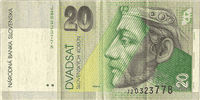 Obverse side of the 20 Slovak korunas is showing the portrait of Prince Pribina, the first known Slovak ruler whose seat was in Nitra until AD 833. |
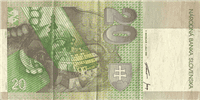 Reverse side of the 20 Slovak korunas is showing a witness to the rich history of the town of Nitra, which has been the centre of a significant political formation - the Principality of Nitra - until the 11th century. Several times the main design is overprinted by part of a coral necklace dating from the 9th century with a crescent-shaped bronze locket, which was found by archaeologists at Nitra-Lupky. |
| 50 Slovak korunas | |
|---|---|
| Banknote of 50 Slovak korunas has dimensions 135×68 mm and main colors are lapis lazuli, celestial blue, celestial blue, pastel blue, platinum, linen, cool grey, wild blue yonder and timberwolf. The banknote of 50 Slovak korunas was issued in 2005. | |
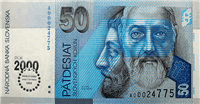 Obverse side of the 50 Slovak korunas is showing the portraits of Saint Cyril and Saint Methodius - the first Slav missionaries. |
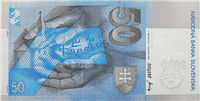 Reverse side of the 50 Slovak korunas is showing two hands, with the first seven letters of the old Slavonic alphabet "Hlaholika" between them, as a symbol of the gift the two saints brought to the ancient Slavs. The symmetrically reversed silhouette of the medieval church at Drazovce (District of Nitra) symbolizes the dawn of Christianity in our country. |
| 100 Slovak korunas | |
|---|---|
| Banknote of 100 Slovak korunas has dimensions 141×71 mm and main colors are khaki, cinereous, grullo, pale silver, champagne, ivory, cornsilk and dim gray. The banknote of 100 Slovak korunas was issued in 2004. | |
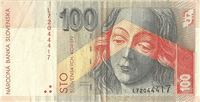 Obverse side of the 100 Slovak korunas is showing the Madonna from the Altar of Birth in St. Jacob's Church at Levoca. This Gothic ornamental sculpture was the work of the outstanding medieval artist - sculptor and woodcarver Master Pavol of Levoca. |
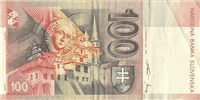 Reverse side of the 100 Slovak korunas is showing the two dominants of the town - the church of the St. Jacob and the city hall. This motive is overprinted by an illustration of a gothic stone head from the sacristy of the old church of the minorite order at Levoca. |
| 200 Slovak korunas | |
|---|---|
| Banknote of 200 Slovak korunas has dimensions 146×73 mm and main colors are teal blue, powder blue, dark jungle green, pale aqua, dark electric blue, outer space, isabelline and timberwolf. The banknote of 200 Slovak korunas was issued in 2006. | |
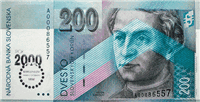 Obverse side of the 200 Slovak korunas is showing an effigy of Anton Bernolak (1762 - 1813), an outstanding linguist and enlightened priest, who played an important role in the movement for national emancipation. He is known in modern Slovak history as father of the first version of Standard Written Slovak language. |
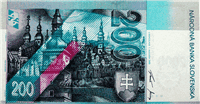 Reverse side of the 200 Slovak korunas is showing the illustration of Trnava in the 18th century and the symbol of the town - the Renaissance City Tower in the foreground. |
| 500 Slovak korunas | |
|---|---|
| Banknote of 500 Slovak korunas has dimensions 153×78 mm and main colors are beaver, sand, cinereous, xanadu, almond, wenge, beige, honeydew and dark gray. The banknote of 500 Slovak korunas was issued in 2006. | |
 Obverse side of the 500 Slovak korunas is showing the portrait of Ludovit Stur, one of the greatest Slovak personalities of the 19th century, who was known as the father of the idea of Slovak national emancipation and the founder of the Slovak literary language. |
 Reverse side of the 500 Slovak korunas is showing the Bratislava Castle together with the Baroque St. Michael´s and a part of the Gothic tower of Klarisky Church. The central part of the composition displays the oldest layout of Bratislava dating from the 15th century wood carving CHRONICA PICTA depicting Bratislava Castle, three churches surrounded by a fortification, and a sketch of the River Danube. |
| 1000 Slovak korunas | |
|---|---|
| Banknote of 1000 Slovak korunas has dimensions 159×80 mm and main colors are dark lavender, taupe, cosmic latte, lavender gray, cool grey, liver, manatee and snow. The banknote of 1000 Slovak korunas was issued in 2006. | |
 Obverse side of the 1000 Slovak korunas is showing the portrait of Andrej Hlinka (1864 - 1938), an outstanding personality of modern Slovak history, who played an important role in the national emancipation process and the political development of Slovakia. |
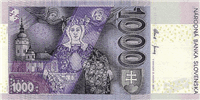 Reverse side of the 1000 Slovak korunas is showing the Madonna, the patron saint depicted in the medieval fresco found in the interior of the Roman Catholic Church in Sliace near Ruzomberok. The left part of the note displays the picture of the Roman Catholic Church of St. Andrew in Ruzomberok. The left part of the Madonna´s cloak contains the picture of Andrej Hlinka´s mausoleum. |
| 5000 Slovak korunas | |
|---|---|
| Banknote of 5000 Slovak korunas has dimensions 164×82 mm and main colors are straw, dark khaki, antique brass, persian orange, grullo, beaver, desert sand, light taupe, sunset, pastel gray and pearl. The banknote of 5000 Slovak korunas was issued in 2003. | |
 Obverse side of the 5000 Slovak korunas is showing the portrait of Milan Rastislav Stefanik (21 July 1880 - 4 May 1919), an outstanding diplomat, politician, soldier, and astronomer. The elements printed on the left side of his portrait illustrate the sun and the moon, representing a part of his life which he dedicated to research and observations in the field of astronomy. |
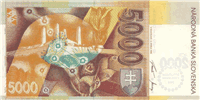 Reverse side of the 5000 Slovak korunas is showing the Stefanik´s grave on Bradlo Hill. The printed design is overlapped by part of the Great Bear constellation, and the lower right and the upper parts of the design carry an illustration of a pasque - flower. |
Useful links
- About National Bank of Slovakia:
- National Bank of Slovakia
- List of currencies:
- Currencies
- Security and design features of SKK banknotes:
- SKK banknotes
- SKK currency on Wikipedia:
- Slovak koruna
- Official Website of National Bank of Slovakia:
- www.nbs.sk
- Commemorative coins:
- Commemorative Coins